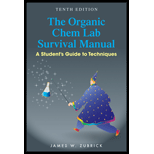
Interpretation:
Select the MSDS for 2-naphthol one from Thermo Fisher and another from J. T. Baker/Mallinckrodt and speculate them as one says this compound will cause death on inhalation, and the other, well, not so much is to be explained and also google the MSDS for sugar.
Concept Introduction:
An
If a person taking organic lab, he/she will stick to hazard data and references in the other handbooks and will be knowledgeable enough.
“A material safety data sheet(MSDS) reflects the hazards of working with the material in an occupational fashion. For example, a MSDS for paint is not highly pertinent to someone who uses a can of paint once a year, but is extremely important to someone who does this in a confined space 40 hours a week.”
Want to see the full answer?
Check out a sample textbook solution
Chapter 1 Solutions
The Organic Chem Lab Survival Manual: A Student's Guide to Techniques
- Nucleophilic Aromatic Substitution: What is the product of the reaction? *see imagearrow_forwardShow the correct sequence to connect the reagent to product. * see imagearrow_forwardThe answer here says that F and K have a singlet and a doublet. The singlet and doublet are referring to the H's 1 carbon away from the carbon attached to the OH. Why don't the H's two carbons away, the ones on the cyclohexane ring, cause more peaks on the signal?arrow_forward
- Draw the Birch Reduction for this aromatic compound and include electron withdrawing groups and electron donating groups. *See attachedarrow_forwardShow the correct sequence to connect the reagent to product. * see imagearrow_forwardBlocking Group are use to put 2 large sterically repulsive group ortho. Show the correct sequence toconnect the reagent to product with the highest yield possible. * see imagearrow_forward
- Elimination-Addition: What molecule was determined to be an intermediate based on a “trapping experiment”? *please solve and see imagearrow_forwardShow the correct sequence to connect the reagent to product. * see imagearrow_forwardPredict the final product. If 2 products are made, list which should be “major” and “minor”. **see attachedarrow_forward
 Organic Chemistry: A Guided InquiryChemistryISBN:9780618974122Author:Andrei StraumanisPublisher:Cengage Learning
Organic Chemistry: A Guided InquiryChemistryISBN:9780618974122Author:Andrei StraumanisPublisher:Cengage Learning EBK A SMALL SCALE APPROACH TO ORGANIC LChemistryISBN:9781305446021Author:LampmanPublisher:CENGAGE LEARNING - CONSIGNMENT
EBK A SMALL SCALE APPROACH TO ORGANIC LChemistryISBN:9781305446021Author:LampmanPublisher:CENGAGE LEARNING - CONSIGNMENT

